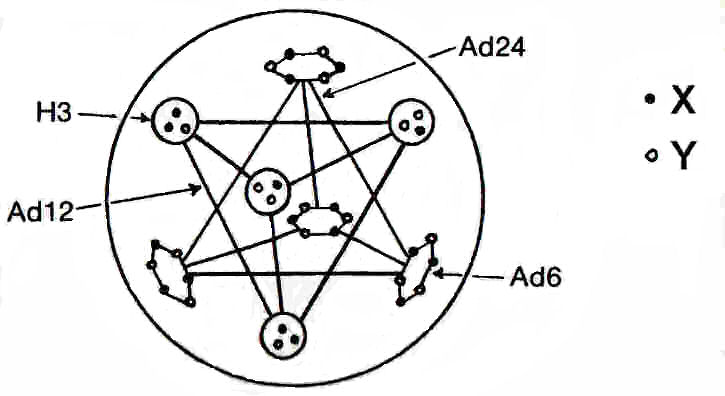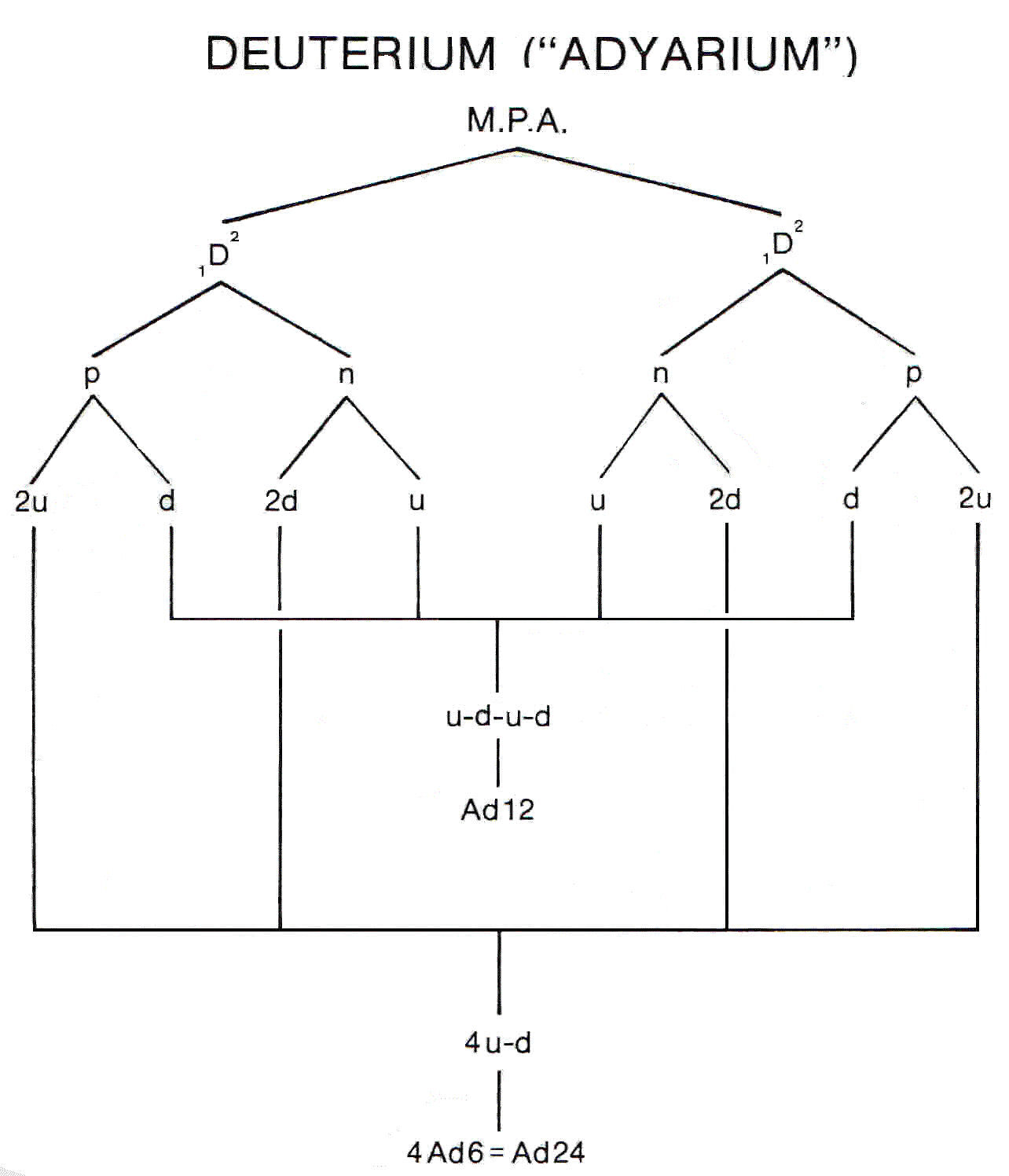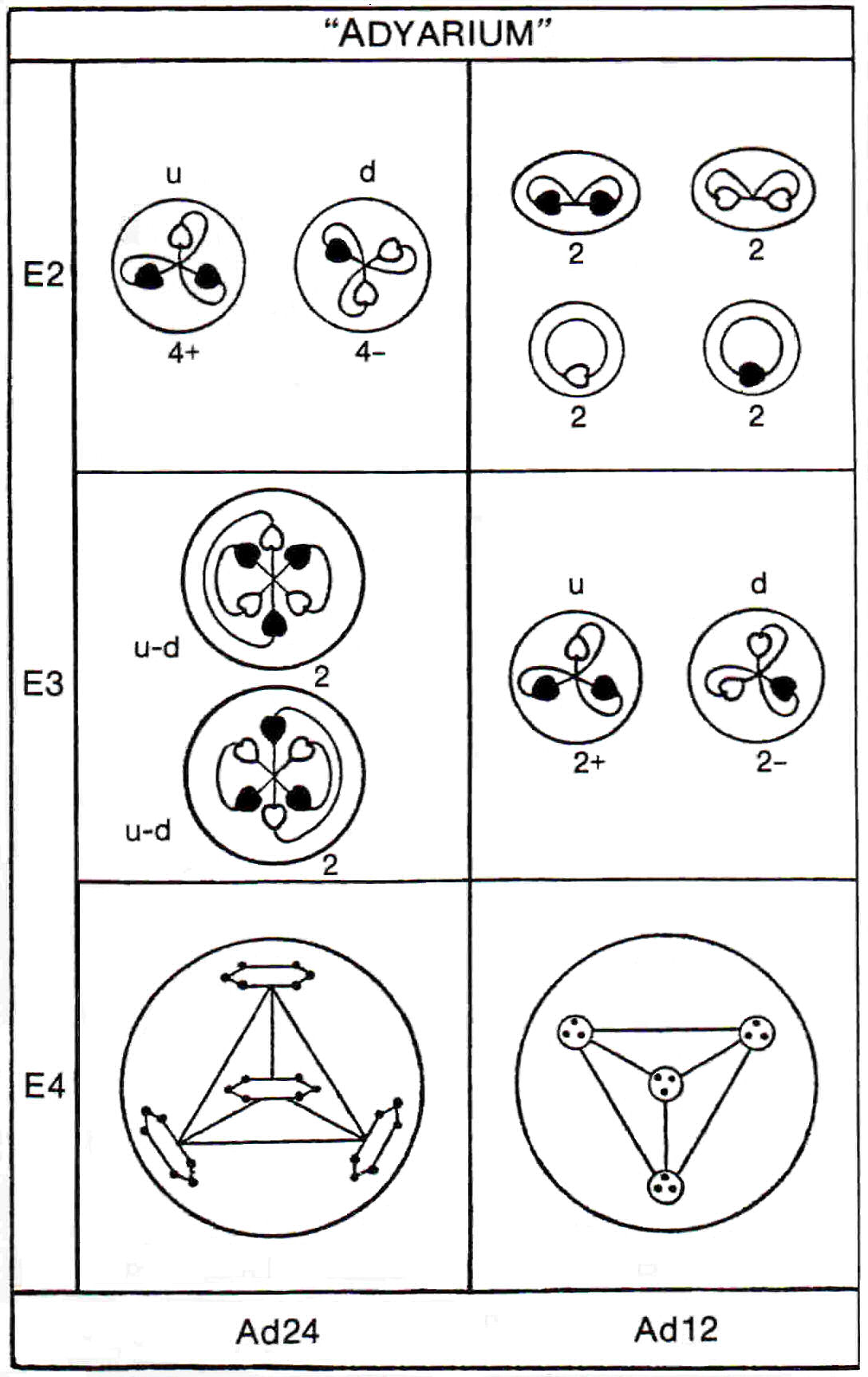
The Deuterium ("Adyarium") MPA
This MPA was announced in the December, 1932 issue of The Theosophist. It was detected in the atmosphere at Adyar, a suburb in south Chennai (formerly Madras) in the state of Tamil Nadu, India (hence its name). However, Besant & Leadbeater regarded it as a new element, even though it had a number weight of 2, thus making deuterium the only possible source. This isotope of hydrogen (so-called 'heavy hydrogen') had been discovered in the previous year by H. Urey and his colleagues. The two Theosophists did not make this identification because they had earlier come to believe (wrongly, as it turns out) that an object seen during the electrolysis of water was an atom of deuterium because it consisted of two hydrogen MPAs, even though they reported1 the object as unstable, yet presumably knew by then that the atom of heavy hydrogen is stable.
Adyarium consists of a sphere containing a tetrahedral array (Ad24) of four cigar-shaped groups of six UPAs (Ad6) and a tetrahedral array (Ad12) of four H3 triplets. The tetrahedra interlace each other. Each Ad6 revolves rapidly around its long axis, making it look "like a pencil sharpened at both ends."2
Deuterium MPA = Ad12 + Ad24.

The Adyarium MPA.
Adyarium is the MPA of deuterium resulting from micro-psi examination of a molecule of deuterium. Each of the two protons in the two deuterons in the molecule breaks up prior to observation of the MPA into a d quark and a u-u diquark; each of the two neutrons breaks up into a u quark and a d-d diquark. The two u quarks and the two d quarks interact to form a bound state of four quarks, which is permitted because they are embedded in a phrase of the Higgs vacuum that is no longer superconducting, so that the four particles are bound not by string forces but by the residual strong interaction between them, in a way analogous to how the nuclear force binds protons and neutrons together in atomic nuclei. This bound state is the Ad12 group. The two u-u diquarks and the two d-d diquarks interact to form a bound


state — the Ad24. The Ad6 is either a u-u or a d-d diquark. As the u quark has an electric charge of +2/3 and the d quark has an electric charge of −1/3, two Ad6 groups in the Ad24 are predicted to be positively charged and two Ad6 groups are predicted to be negatively charged. This is confirmed by the text in both the 1st and 3rd editions of Occult Chemistry, the former stating that "two cigars are positive and two negative"3 and the latter stating that "On the E3 level the Ad24 gives 4 sextets, 4 Ad6, two positive and two negative."4 Furthermore, the disintegration diagram above shows that the Ad24 breaks up into four positive triplets (u quarks) and four negative triplets (d quarks), confirming its predicted quark composition. It also indicates that the Ad12 breaks up at stage E3 into two positive triplets (u quarks) and two negative triplets (d quarks), in agreement with the predicted composition of this bound state.
The deuterium MPA is therefore the result of each proton in the two deuterons under micro-psi examination dissociating into a d quark and a u-u diquark and of each neutron breaking up into a u quark and a d-d diquark, the freed quarks forming the Ad12 and the freed diquarks forming the Ad24. Every detail of the description of Adyarium is explained. The simplicity of this perfect correlation between the quark model, simple facts of nuclear physics and the particles in the deuterium MPA constitutes highly convincing evidence of the author's theory that the MPA of an element is formed by the interaction and recombination of all the particles making up two atomic nuclei of that element, once they have been freed, the process that accomplishes this being described in depth in his books Extra-sensory Perception of Quarks and ESP of Quarks and Superstrings. The description of Adyarium was published in 1932, which was the year when James Chadwick discovered the neutron and Heisenberg proposed that it is present in atomic nuclei. It would be another 32 years before physicists Murray Gell-Mann and George Zweig proposed the theory of quarks. The fact that Besant & Leadbeater reported Adyarium to break up into six positive triplets and six negative triplets, i.e., six up quarks and six d quarks — precisely what the quark model predicts for the composition of the two protons and two neutrons in two deuterons — is incontrovertible evidence that quarks were remote-viewed. The disbelieving sceptic cannot offer any explanation other than it was just by chance that this particular number of triplets of each type were detailed. The reader may feel ready to dismiss that suggestion with the contempt it deserves by the time he finishes studying the analyses of the MPAs of the first twenty elements (as well as gold). For he will find in them similar exact matching between theory and observation that renders extremely implausible the possibility of its being due to coincidence in every case.
References